

CN 11-1911/B
主办:中国心理学会
中国科学院心理研究所
出版:科学出版社


心理学报 ›› 2024, Vol. 56 ›› Issue (4): 394-411.doi: 10.3724/SP.J.1041.2024.00394 cstr: 32110.14.2024.00394
收稿日期:2022-10-27
发布日期:2024-01-17
出版日期:2024-04-25
通讯作者:
李宝林, E-mail: lblpsy@snnu.edu.cn基金资助:
WANG Biyao, CHEN Chen, HU Xiaofei, WANG Di, LI Baolin( )
)
Received:2022-10-27
Online:2024-01-17
Published:2024-04-25
摘要:
个体当前的知觉反应不仅取决于当前的刺激输入, 而且依赖于先前的感知经验, 可表现为知觉的序列依赖效应。结合时距二分任务, 通过3个实验系统改变先前试次和当前试次中刺激的位置关系, 考察了时距知觉的序列依赖效应及其空间迁移性。结果发现, (1)先前试次的刺激时距导致了排斥性的刺激序列依赖效应, 并且这种效应能够完全迁移到不同的空间位置; (2)先前试次的决策反应导致了吸引性的决策序列依赖效应, 但该效应仅能部分迁移到不同的空间位置; (3)时距知觉的刺激和决策序列依赖效应的空间迁移性不受空间类型(外部空间 vs. 视网膜空间)的调节。这些结果在一定程度上反映了视觉时距知觉序列依赖效应产生的潜在神经位置: 刺激序列依赖效应可能产生于对空间信息不敏感或具有较大感受野的较高级视觉加工脑区; 决策序列依赖效应则可能源于具有类别组织功能的高级认知脑区。
中图分类号:
王碧瑶, 陈晨, 胡晓斐, 王迪, 李宝林. (2024). 视觉时距知觉序列依赖效应的空间迁移性. 心理学报, 56(4), 394-411.
WANG Biyao, CHEN Chen, HU Xiaofei, WANG Di, LI Baolin. (2024). Spatial generalization of serial dependence in visual duration perception. Acta Psychologica Sinica, 56(4), 394-411.

图1 实验流程图。(A)实验1正式测试的流程: 首先在距屏幕中央左侧5°的位置呈现500 ms的红色注视点, 要求被试在实验全程注视该点, 接着随机在注视点或注视点右侧10°位置呈现一个时长为300~900 ms的测试刺激, 在测试刺激消失后被试需判断测试刺激的呈现时间相比记忆中的参照刺激的呈现时间“较长”还是“较短”, 并进行按键反应。(B)实验2的测试流程同实验1, 不同之处仅在于注视点呈现在屏幕中央, 此时测试刺激随机呈现在注视点左侧或右侧5°的位置。

图2 概率选择模型示意图。对某个被试当前的知觉决策而言, 它由4种因素共同决定, 即基线偏差( β 0)、当前试次的刺激时距信息( β c u r r _ s t i m u l u s)、先前试次的刺激时距信息( β p r e v _ s t i m u l u s)、先前试次的决策反应信息( β p r e v _ c h o i c e)。图中刺激和反应轴上的竖线条分别表示刺激时距和决策反应。绿色线条表示当前试次(t)的刺激时距信息, 红色线条表示紧邻的前一试次(t−1)的刺激时距信息, 蓝色线条表示紧邻的前一试次的决策反应信息。该模型中个体当前的时距知觉决策反应概率(P (L))由这4种因素通过二项逻辑回归函数的方式决定。
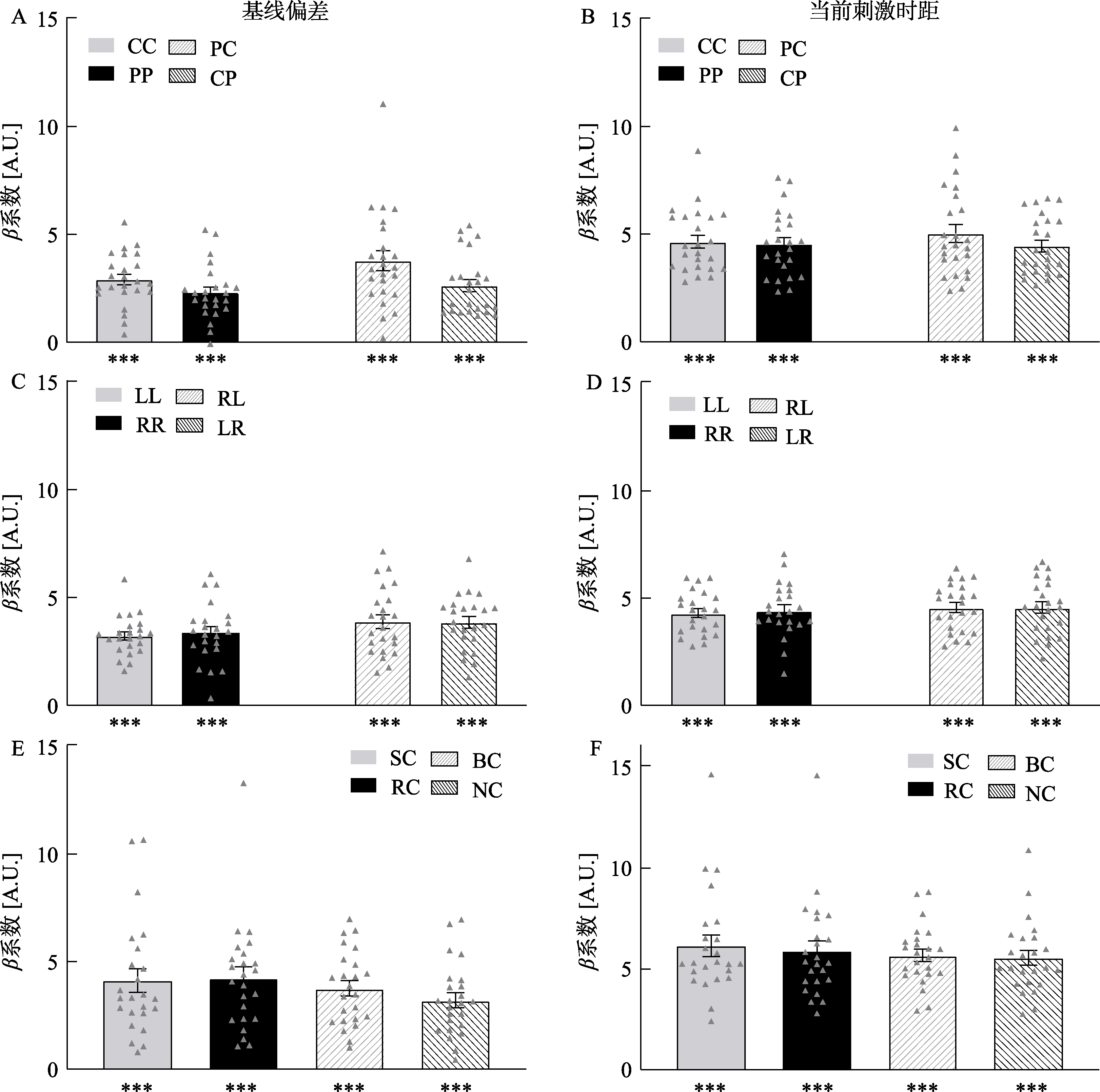
图S1 基线偏差与当前刺激时距的 β系数( β 0和 β c u r r _ s t i m u l u s)在不同位置条件下的大小(A、B为实验1结果, C、D为实验2结果, E、F为实验3结果)。CC代表前一试次呈现在中央视野, 当前试次也呈现在中央视野; PP代表前一试次呈现在外周视野, 当前试次也呈现在外周视野; PC代表前一试次呈现在外周视野, 当前试次呈现在中央视野; CP代表前一试次呈现在中央视野, 当前试次呈现在外周视野; LL代表前一试次呈现在左侧视野, 当前试次也呈现在左侧视野; RR代表前一试次呈现在右侧视野, 当前试次也呈现在右侧视野; RL代表前一试次呈现在右侧视野, 当前试次呈现在左侧视野; LR代表前一试次呈现在左侧视野, 当前试次呈现在右侧视野; SC代表当前试次与前一试次的注视点、光斑刺激位置都不同, 但两者的相对位置一致; RC代表当前试次与前一试次的注视点不同, 但光斑刺激位置不变; BC代表当前试次与前一试次光斑刺激的呈现位置以及光斑刺激与注视点之间的相对位置不同, 但注视点位置不变; NC代表当前试次与前一试次的注视点、光斑刺激的呈现位置相同。图中灰色三角形代表每种条件下每名被试的数据点; 误差线代表标准误差; ***p < 0.001。

图3 实验1心理测量结果。(A)一名代表性被试在不同位置条件下(中央视野 vs. 外周视野)的心理测量函数(累积高斯函数)曲线。横坐标为测试刺激的呈现时间, 纵坐标为被试判断测试刺激呈现时间“较长”的比例。图中灰色曲线代表中央视野, 黑色曲线代表外周视野; 灰色与黑色实心圆点分别代表不同视野下该名被试在不同时距下的“较长”反应比例。(B)不同位置条件下时距知觉的准确性(|PSE − 520|); (C)不同位置条件下时距知觉的感受性(JND)。图中灰色条形图代表中央视野, 黑色条形图代表外周视野; 灰色三角形代表每种条件下每名被试的数据点。误差线代表每种条件下平均值的标准误差; ***p < 0.001, **p < 0.01。
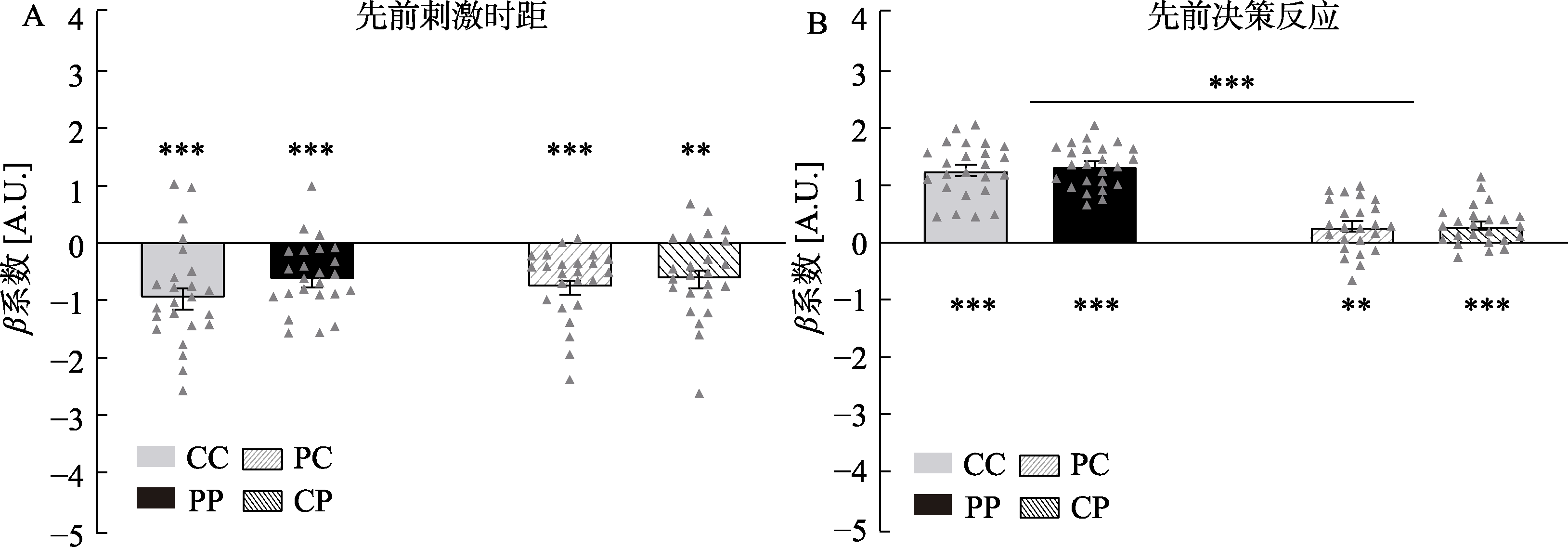
图4 实验1模型中基于先前刺激时距(A)和决策反应(B)的 β系数在不同条件下的大小。灰色实心条形图CC代表前一试次呈现在中央视野, 当前试次也呈现在中央视野; 黑色实心条形图PP代表前一试次呈现在外周视野, 当前试次也呈现在外周视野; 浅色条纹条形图PC代表前一试次呈现在外周视野, 当前试次呈现在中央视野; 深色条纹条形图CP代表前一试次呈现在中央视野, 当前试次呈现在外周视野。图中灰色三角形代表每种条件下每名被试的数据点; 误差线代表标准误差; ***p < 0.001, **p < 0.01。
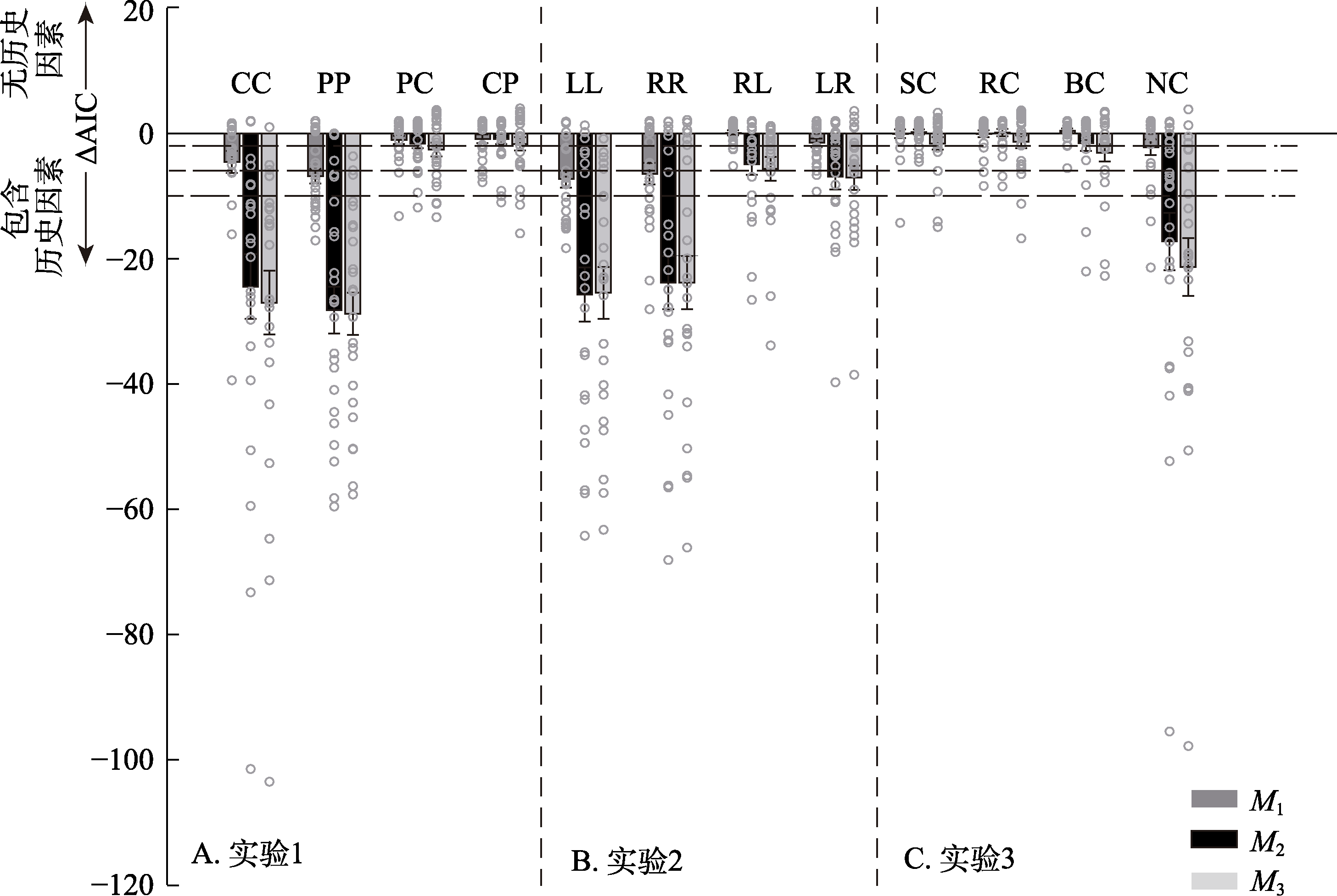
图5 实验1、实验2和实验3在不同条件下的模型比较结果。横坐标为不同的实验条件, 纵坐标为包含历史因素模型(深灰色条形图 M 1代表“stimulus-history”模型, 黑色条形图 M 2代表“choice-history”模型, 浅灰色条形图 M 3代表“stimulus and choice history”模型)与无历史因素模型( M 0)的AIC差值( ΔAIC)。平行于横坐标的虚线作为 ΔAIC = −10 (下), ΔAIC = −6 (中)和 ΔAIC = −2 (上)的标记。当 ΔAIC的绝对量值在2~6, 6~10, 或大于10时, 分别表明存在肯定的, 强烈的或非常强的证据支持AIC值小的模型。灰色空心圆代表每种条件下每名被试的 ΔAIC; 误差线代表标准误差。

图6 实验2心理测量结果。(A)一名代表性被试在不同位置条件下(左侧视野 vs. 右侧视野)的心理测量函数(累积高斯函数)曲线。横坐标为测试刺激的呈现时间, 纵坐标为被试判断测试刺激呈现时间“较长”的比例。图中灰色曲线代表左侧视野, 黑色曲线代表右侧视野; 灰色与黑色实心圆点分别代表不同视野下该名被试在不同时距下的“较长”反应比例。(B)不同位置条件下时距知觉的准确性(|PSE−520|); (C)不同位置条件下时距知觉的感受性(JND)。图中灰色条形图代表左侧视野, 黑色条形图代表右侧视野; 灰色三角形代表每种条件下每名被试的数据点。误差线代表每种条件下平均值的标准误差。
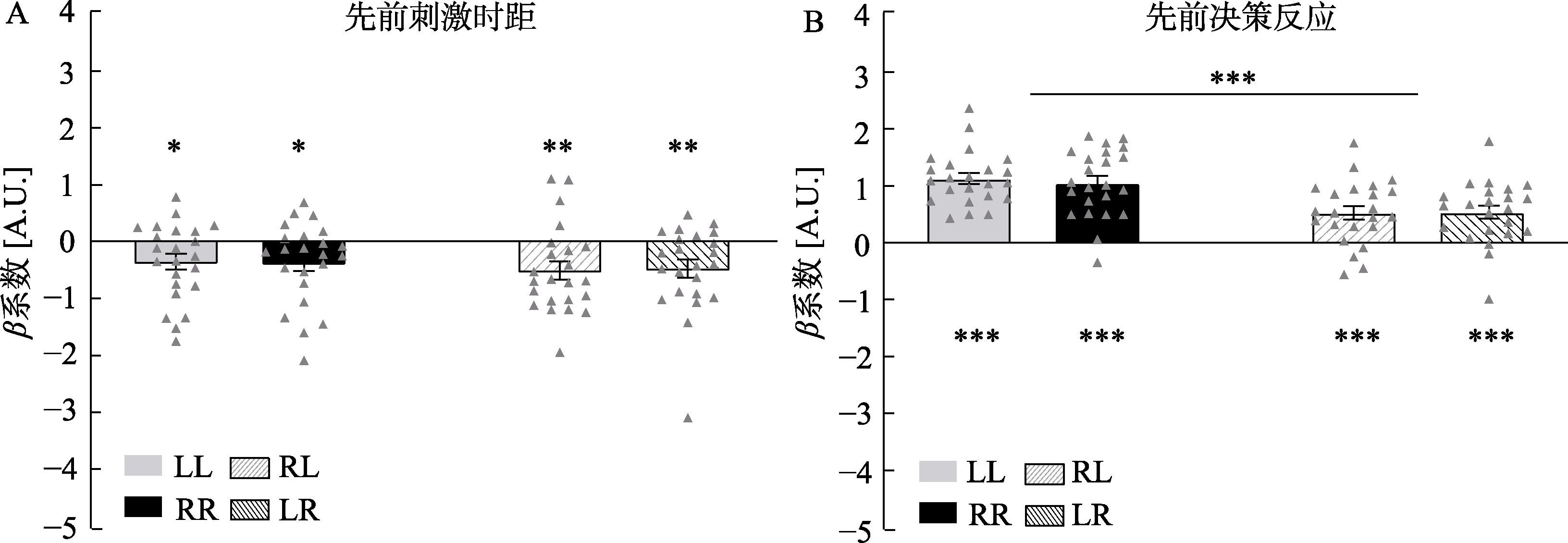
图7 实验2模型中基于先前刺激时距(A)和决策反应(B)的 β系数在不同条件下的大小。灰色实心条形图LL代表前一试次呈现在左侧视野, 当前试次也呈现在左侧视野; 黑色实心条形图RR代表前一试次呈现在右侧视野, 当前试次也呈现在右侧视野; 浅色条纹条形图RL代表前一试次呈现在右侧视野, 当前试次呈现在左侧视野; 深色条纹条形图LR代表前一试次呈现在左侧视野, 当前试次呈现在右侧视野。图中灰色三角形代表每种条件下每名被试的数据点; 误差线代表标准误差; ***p < 0.001, **p < 0.01, *p < 0.05。
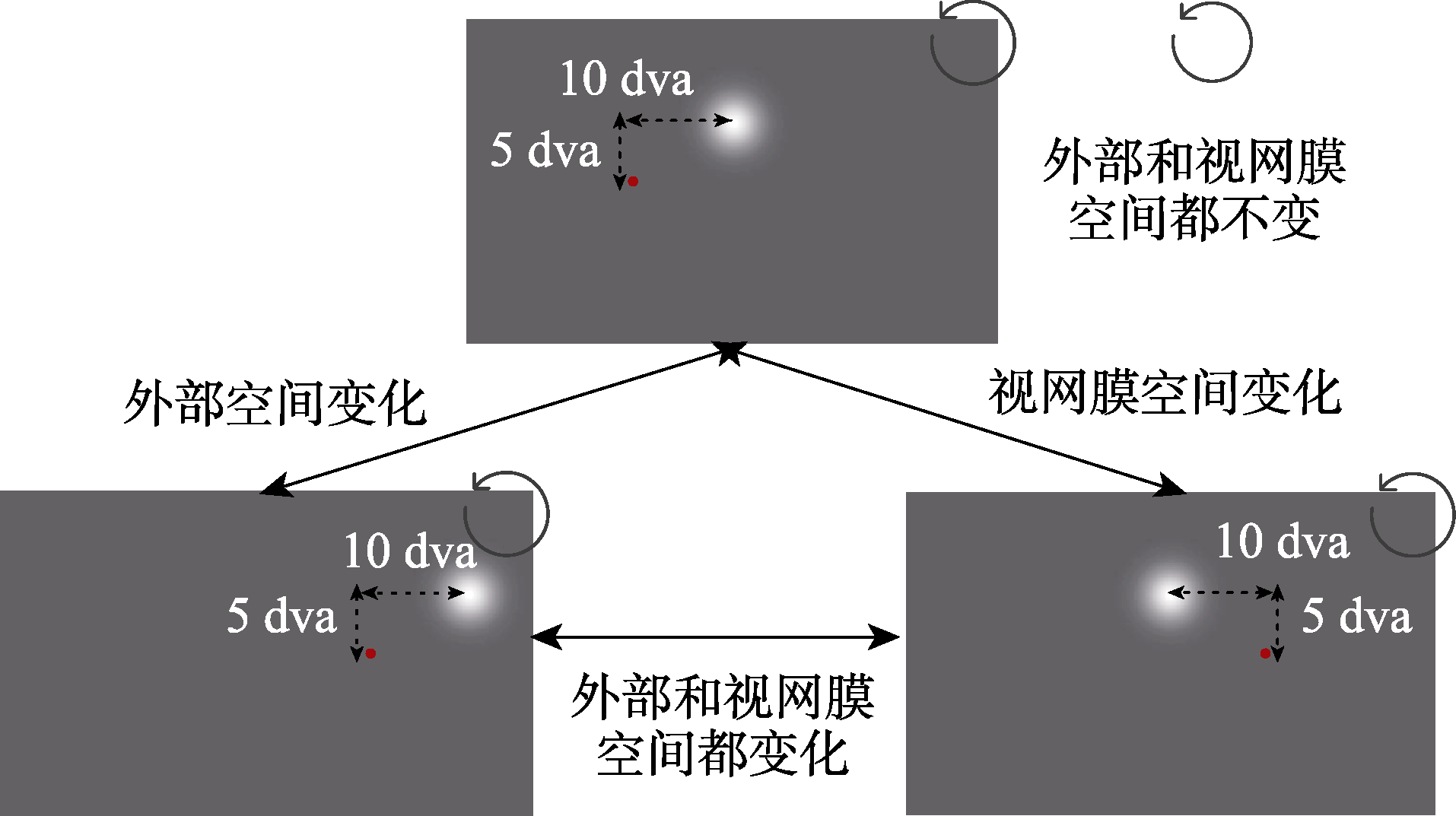
图8 刺激位置关系说明图。根据先前试次和当前试次中刺激的位置关系, 共分为4种条件: 外部空间变化(SC), 即先前和当前试次中刺激的外部空间位置发生变化, 但它们在视网膜空间的相对位置不变; 视网膜空间变化(RC), 即先前和当前试次中刺激在视网膜空间的相对位置发生变化, 但它们的外部空间位置不变; 外部和视网膜空间都变化(一致变化条件; BC), 即先前和当前试次中刺激的外部空间位置和视网膜空间的相对位置都发生变化; 外部和视网膜空间都不变(一致不变条件; NC), 即先前和当前试次中刺激的外部空间位置和视网膜空间的相对位置都保持一致。刺激与注视点的位置关系通过垂直和水平的视角度数(dav: degree of visual angle)标记。

图9 实验3心理测量结果。(A)一名代表性被试在不同刺激类型条件下(LUC vs. RUC vs. RUR)的心理测量函数(累积高斯函数)曲线。横坐标为测试刺激的呈现时间, 纵坐标为被试判断测试刺激呈现时间“较长”的比例。图中灰色实曲线代表LUC条件, 即注视点位于屏幕中央左侧, 视觉刺激位于屏幕中央上方; 黑色实曲线代表RUC条件, 即注视点位于屏幕中央右侧, 视觉刺激位于屏幕中央上方; 灰色虚曲线代表RUR条件, 即注视点位于屏幕中央右侧, 视觉刺激位于注视点右上方; 不同颜色的实心圆点分别代表不同刺激类型条件下该名被试在不同时距下的长反应比例。(B)不同刺激类型条件下时距知觉的准确性(|PSE−520|); (C)不同刺激类型条件下时距知觉的感受性(JND)。图中灰色三角形代表每种条件下每名被试的数据点; 误差线代表平均值的标准误差; *p < 0.05。
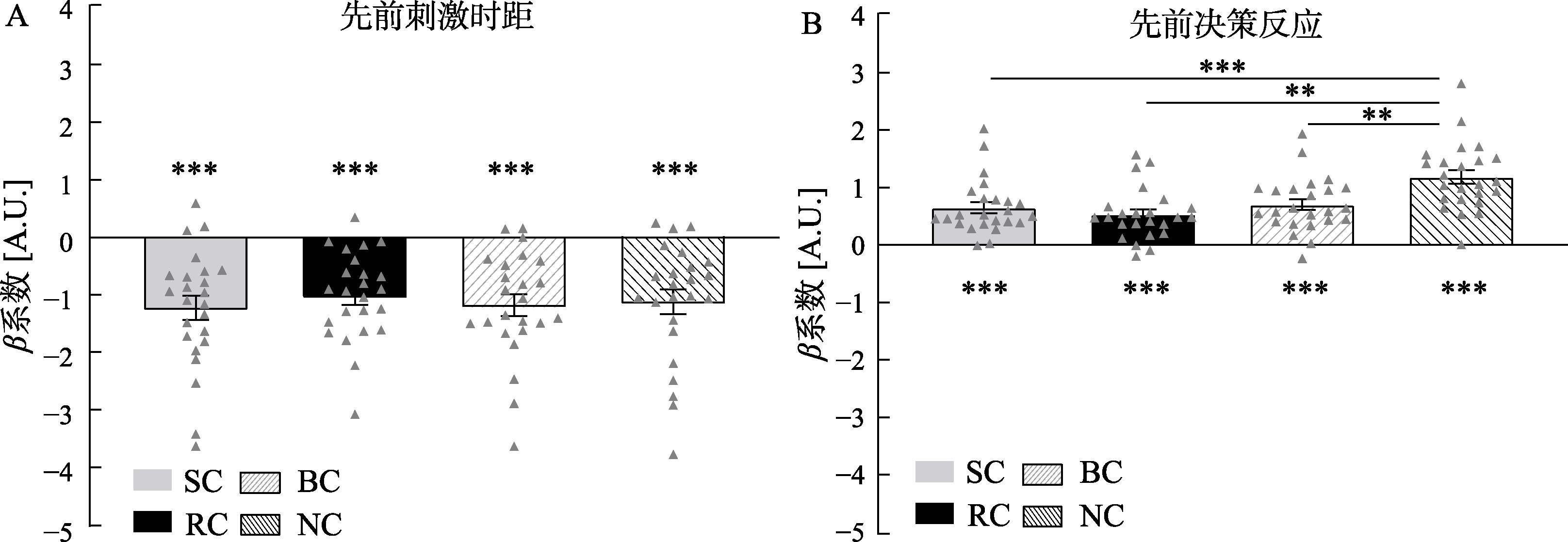
图10 实验3模型中基于先前刺激时距(A)和决策反应(B)的 β系数在不同条件下的大小。灰色实心条形图SC代表当前试次与前一试次的注视点、光斑刺激位置都不同, 但两者的相对位置一致; 黑色实心条形图RC代表当前试次与前一试次的注视点不同, 但光斑刺激位置不变; 浅色条纹条形图BC代表当前试次与前一试次光斑刺激的呈现位置以及光斑刺激与注视点之间的相对位置不同, 但注视点位置不变; 深色条纹条形图NC代表当前试次与前一试次的注视点、光斑刺激的呈现位置相同。图中灰色三角形代表每种条件下每名被试的数据点; 误差线代表标准误差; ***p < 0.001, **p < 0.01。
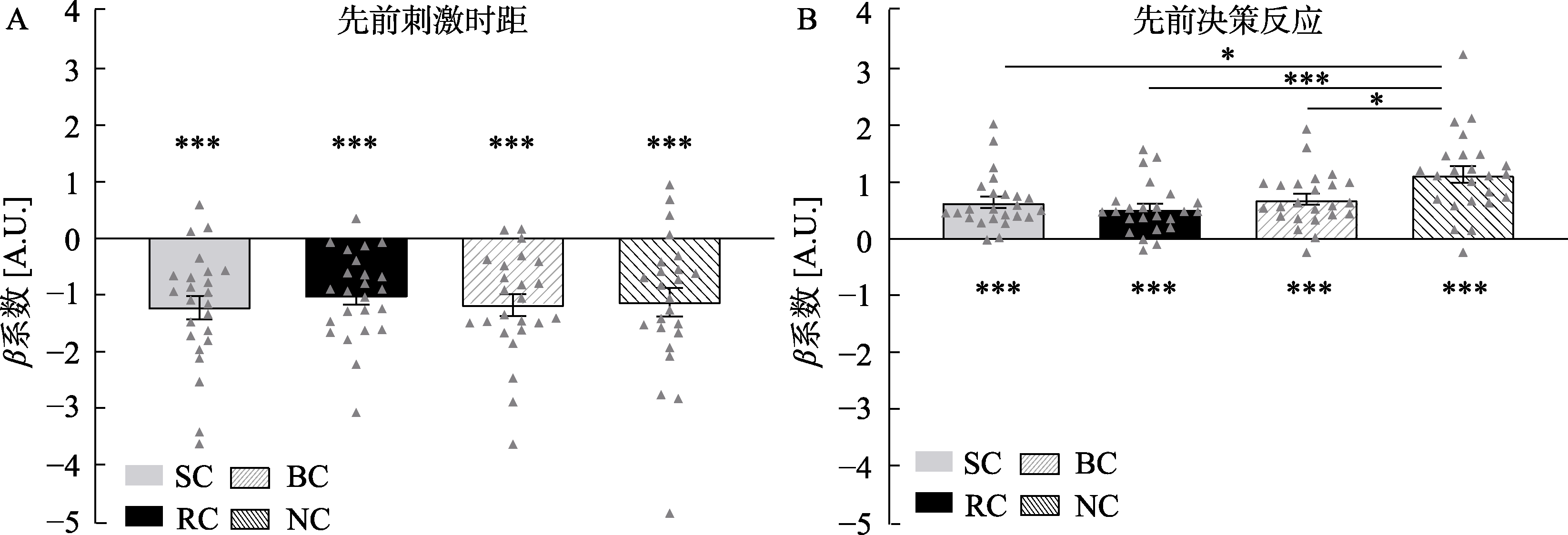
图S2 实验3中前一试次的刺激时距(A)与决策反应(B)的 β系数( β p r e v _ s t i m u l u s和 β p r e v _ c h o i c e)在不同位置条件下的大小(随机化结果)。SC代表当前试次与前一试次的注视点、光斑刺激位置都不同, 但两者的相对位置一致; RC代表当前试次与前一试次的注视点不同, 但光斑刺激位置不变; BC代表当前试次与前一试次光斑刺激的呈现位置以及光斑刺激与注视点之间的相对位置不同, 但注视点位置不变; NC代表当前试次与前一试次的注视点、光斑刺激的呈现位置相同。图中灰色三角形代表每种条件下每名被试的数据点; 误差线代表标准误差; ***p < 0.001, *p < 0.05。
| [1] |
Akaishi, R., Umeda, K., Nagase, A., & Sakai, K. (2013). Autonomous mechanism of internal choice estimate underlies decision inertia. Neuron, 81(1), 195-206.
doi: 10.1016/j.neuron.2013.10.018 URL |
| [2] |
Amano, K., Wandell, B. A., & Dumoulin, S. O. (2009). Visual field maps, population receptive field sizes, and visual field coverage in the human MT+ complex. Journal of Neurophysiology, 102(5), 2704-2718.
doi: 10.1152/jn.00102.2009 pmid: 19587323 |
| [3] |
Brainard, D. H. (1997). The psychophysics toolbox. Spatial Vision, 10(4), 433-436.
pmid: 9176952 |
| [4] |
Brimijoin, W. O., & O'Neill, W. E. (2010). Patterned tone sequences reveal non-linear interactions in auditory spectrotemporal receptive fields in the inferior colliculus. Hearing Research, 267(1-2), 96-110.
doi: 10.1016/j.heares.2010.04.005 pmid: 20430078 |
| [5] |
Burr, D., Tozzi, A., & Morrone, M. C. (2007). Neural mechanisms for timing visual events are spatially selective in real-world coordinates. Nature Neuroscience, 10(4), 423-425.
doi: 10.1038/nn1874 pmid: 17369824 |
| [6] | Cicchini, G. M., Benedetto, A., & Burr, D. C. (2021). Perceptual history propagates down to early levels of sensory analysis. Current Biology, 31(6), 1245-1250. |
| [7] |
Duhamel, J. -R., Bremmer, F., Ben Hamed, S., & Graf, W. (1997). Spatial invariance of visual receptive fields in parietal cortex neurons. Nature, 389(6653), 845-848.
doi: 10.1038/39865 |
| [8] |
Fang, F., Murray, S. O., Kersten, D., & He, S. (2005). Orientation-tuned fMRI adaptation in human visual cortex. Journal of Neurophysiology, 94(6), 4188-4195.
pmid: 16120668 |
| [9] |
Faul, F., Erdfelder, E., Lang, A. -G., & Buchner, A. (2007). G*Power 3: A flexible statistical power analysis program for the social, behavioral, and biomedical sciences. Behavior Research Methods, 39(2), 175-191.
doi: 10.3758/bf03193146 pmid: 17695343 |
| [10] | Feigin, H., Baror, S., Bar, M., & Zaidel, A. (2021). Perceptual decisions are biased toward relevant prior choices. Scientific Reports, 11(1), 648. |
| [11] | Feigin, H., Shalom-Sperber, S., Zachor, D. A., & Zaidel, A. (2021). Increased influence of prior choices on perceptual decisions in autism. Elife, 10, e61595. |
| [12] | Fischer, C., Czoschke, S., Peters, B., Rahm, B., & Bledowski, C. (2020). Context information supports serial dependence of multiple visual objects across memory episodes. Nature Communications, 11(1), 889-920. |
| [13] |
Fischer, J., & Whitney, D. (2014). Serial dependence in visual perception. Nature Neuroscience, 17(5), 738-743.
doi: 10.1038/nn.3689 pmid: 24686785 |
| [14] |
Gattass, R., Sousa, A. P., & Gross, C. G. (1988). Visuotopic organization and extent of V3 and V4 of the macaque. Journal of Neuroscience, 8(6), 1831-1845.
pmid: 3385477 |
| [15] |
Harvey, B. M., & Dumoulin, S. O. (2011). The relationship between cortical magnification factor and population receptive field size in human visual cortex: Constancies in cortical architecture. Journal of Neuroscience, 31(38), 13604-13612.
doi: 10.1523/JNEUROSCI.2572-11.2011 pmid: 21940451 |
| [16] |
Hayashi, M. J., & Ivry, R. B. (2020). Duration selectivity in right parietal cortex reflects the subjective experience of time. Journal of Neuroscience, 40(40), 7749-7758.
doi: 10.1523/JNEUROSCI.0078-20.2020 pmid: 32928883 |
| [17] | Heron, J., Aaen-Stockdale, C., Hotchkiss, J., Roach, N. W., McGraw, P. V., & Whitaker, D. (2012). Duration channels mediate human time perception. Proceedings of the Royal Society B: Biological Sciences, 279(1729), 690-698. |
| [18] | Huang, X. T., Guo, X. Y., & Nie, J. (2003). The relationship between temporal and non-temporal information in cognitive processing. Journal of Psychological Science, 26(5), 770-774. |
| [黄希庭, 郭秀艳, 聂晶. (2003). 认知加工中时间与非时间信息的相互关系. 心理科学, 26(5), 770-774.] | |
| [19] | Hwang, E. J., Dahlen, J. E., Mukundan, M., & Komiyama, T. (2017). History-based action selection bias in posterior parietal cortex. Nature Communications, 8(1), 1242. |
| [20] |
Kass, R. E., & Raftery, A. E. (1995). Bayes factors. Journal of the American Statistical Association, 90(430), 773-795.
doi: 10.1080/01621459.1995.10476572 URL |
| [21] |
Kastner, S., De Weerd, P., Pinsk, M. A., Elizondo, M. I., Desimone, R., & Ungerleider, L. G. (2001). Modulation of sensory suppression: Implications for receptive field sizes in the human visual cortex. Journal of Neurophysiology, 86(3), 1398-1411.
doi: 10.1152/jn.2001.86.3.1398 pmid: 11535686 |
| [22] | Knapen, T., Rolfs, M., Wexler, M., & Cavanagh, P. (2010). The reference frame of the tilt aftereffect. Journal of Vision, 10(1), 1-13. |
| [23] | Leys, C., Ley, C., Klein, O., Bernard, P., & Licata, L. (2013). Detecting outliers: Do not use standard deviation around the mean, use absolute deviation around the median. Journal of Experimental Social Psychology, 49(4), 764-766. |
| [24] | Li, B., Wang, B., & Zaide, A. (2023). Modality-specific sensory and decisional carryover effects in duration perception. BMC Biology, 21(1), 48. |
| [25] |
Li, B., Xiao, L., Yin, H., Liu, P., & Huang, X. (2017). Duration aftereffect depends on the duration of adaptation. Frontiers in Psychology, 8,491.
doi: 10.3389/fpsyg.2017.00491 pmid: 28424646 |
| [26] |
Li, B., Yuan, X., Chen, Y., Liu, P., & Huang, X. (2015). Visual duration aftereffect is position invariant. Frontiers in Psychology, 6,1536.
doi: 10.3389/fpsyg.2015.01536 pmid: 26500591 |
| [27] |
Li, B., Yuan, X., & Huang, X. (2015). The aftereffect of perceived duration is contingent on auditory frequency but not visual orientation. Scientific Reports, 5,10124.
doi: 10.1038/srep10124 pmid: 26054927 |
| [28] |
Liberman, A., Fischer, J., & Whitney, D. (2014). Serial dependence in the perception of faces. Current Biology, 24(21), 2569-2574.
doi: 10.1016/j.cub.2014.09.025 pmid: 25283781 |
| [29] | Manassi, M., Kristjansson, A., & Whitney, D. (2019). Serial dependence in a simulated clinical visual search task. Scientific Reports, 9(1), 19937. |
| [30] |
Matthews, W. J., & Meck, W. H. (2016). Temporal cognition: Connecting subjective time to perception, attention, and memory. Psychological Bulletin, 142(8), 865-907.
doi: 10.1037/bul0000045 pmid: 27196725 |
| [31] |
Merchant, H., Harrington, D. L., & Meck, W. H. (2013). Neural basis of the perception and estimation of time. Annual Review of Neuroscience, 36,313-336.
doi: 10.1146/annurev-neuro-062012-170349 pmid: 23725000 |
| [32] | Michele, F., & Joonkoo, P. (2018). Serial dependence in numerosity perception. Journal of Vision, 18(9), 15, 1-12. |
| [33] |
Mochol, G., Kiani, R., & Moreno-Bote, R. (2021). Prefrontal cortex represents heuristics that shape choice bias and its integration into future behavior. Current Biology, 31(6), 1234-1244.e6.
doi: 10.1016/j.cub.2021.01.068 URL |
| [34] | Moon, J., & Kwon, O. S. (2022). Attractive and repulsive effects of sensory history concurrently shape visual perception. BMC Biology, 20(1), 247. |
| [35] |
Nagai, Y., Suzuki, M., Miyazaki, M., & Kitazawa, S. (2012). Acquisition of multiple prior distributions in tactile temporal order judgment. Frontiers in Psychology, 3, 276.
doi: 10.3389/fpsyg.2012.00276 pmid: 22912622 |
| [36] | Pascucci, D., Mancuso, G., Santandrea, E., Della Libera, C., Plomp, G., & Chelazzi, L. (2019). Laws of concatenated perception: Vision goes for novelty, decisions for perseverance. Plos Biology, 17(3), e3000144. |
| [37] |
Pelli, D. G. (1997). The videotoolbox software for visual psychophysics: Transforming numbers into movies. Spatial Vision, 10(4), 437-442.
pmid: 9176953 |
| [38] |
Petzold, P., & Haubensak, G. (2004). The influence of category membership of stimuli on sequential effects in magnitude judgment. Perception & Psychophysics, 66(4), 665-678.
doi: 10.3758/BF03194910 URL |
| [39] |
Qiu, A., Rosenau, B. J., Greenberg, A. S., Hurdal, M. K., Barta, P., Yantis, S., & Miller, M. I. (2006). Estimating linear cortical magnification in human primary visual cortex via dynamic programming. Neuroimage, 31(1), 125-138.
pmid: 16469509 |
| [40] | Rosenholtz, R. (2016). Capabilities and limitations of peripheral vision. Annual Review of Neuroscience, 2, 437-457. |
| [41] |
Schutt, H. H., Harmeling, S., Macke, J. H., & Wichmann, F. A. (2016). Painfree and accurate bayesian estimation of psychometric functions for (potentially) overdispersed data. Vision Research, 122, 105-123.
doi: S0042-6989(16)00039-0 pmid: 27013261 |
| [42] |
Shapiro, K. L., & Johnson, T. L. (1987). Effects of arousal on attention to central and peripheral visual stimuli. Acta Psychologica, 66(2), 157-172.
pmid: 3687484 |
| [43] |
Shuler, M. G. (2016). Timing in the visual cortex and its investigation. Current Opinion in Behavioral Sciences, 8, 73-77.
pmid: 26949724 |
| [44] |
Smith, A. T., Singh, K. D., Williams, A., & Greenlee, M. (2001). Estimating receptive field size from fMRI data in human striate and extrastriate visual cortex. Cerebral Cortex, 11(12), 1182-1190.
pmid: 11709489 |
| [45] |
St John-Saaltink, E., Kok, P., Lau, H. C., & de Lange, F. P. (2016). Serial dependence in perceptual decisions is reflected in activity patterns in primary visual cortex. Journal of Neuroscience, 36(23), 6186-6192.
doi: 10.1523/JNEUROSCI.4390-15.2016 pmid: 27277797 |
| [46] | Strasburger, H., Rentschler, I., & Juttner, M. (2011). Peripheral vision and pattern recognition: A review. Journal of Vision, 11(5), 13. |
| [47] |
Wandell, B. A., Dumoulin, S. O., & Brewer, A. A. (2007). Visual field maps in human cortex. Neuron, 56(2), 366-383.
doi: 10.1016/j.neuron.2007.10.012 pmid: 17964252 |
| [48] |
Wehrman, J. J., Wearden, J., & Sowman, P. (2020). Decisional carryover effects in interval timing: Evidence of a generalized response bias. Attention, Perception, & Psychophysics, 82(4), 2147-2164.
doi: 10.3758/s13414-019-01922-1 |
| [49] | Wiener, M., Thompson, J. C., & Coslett, H. B. (2014). Continuous carryover of temporal context dissociates response bias from perceptual influence for duration. Plos One, 9(6), e100803. |
| [50] | Zhang, Z. J., Yuan, H., & Huang, X. T. (2006). The difference between sub-and supara-second interval processing: Evidence from an ERP study. Journal of Psychological Science, 29(1), 87-90. |
| [张志杰, 袁宏, 黄希庭. (2006). 不同时距加工机制的比较: 来自ERP的证据(Ⅰ). 心理科学, 29(1), 87-90.] |
| [1] | 刘雨杰, 刘晨淼, 周丽琴, 周可. 任务相关性对数量感序列依赖效应的影响[J]. 心理学报, 2024, 56(3): 255-267. |
| [2] | 尹华站, 肖春花, 夏安妮, 袁中静, 崔晓冰, 李丹. 基本情绪对时距知觉的影响: 来自三水平元分析和网络元分析的证据[J]. 心理学报, 2024, 56(12): 1676-1690. |
| [3] | 尹华站, 张丽, 刘鹏玉, 李丹. 负性情绪的动机维度对时距知觉的影响:注意控制和注意偏向的中介作用[J]. 心理学报, 2023, 55(12): 1917-1931. |
| [4] | 王盼盼, 何嘉梅. 情景预见对跨期决策的影响机制[J]. 心理学报, 2020, 52(1): 38-54. |
| [5] | 刘静远, 李虹. 状态焦虑对时距知觉的影响:认知评价和注意偏向有调节的中介作用[J]. 心理学报, 2019, 51(7): 747-758. |
| [6] | 李宝林;陈有国;袁祥勇;Todd Jackson;黄希庭. 拓扑性质对视觉新异刺激时距知觉的影响[J]. 心理学报, 2013, 45(12): 1324-1333. |
| 阅读次数 | ||||||
|
全文 |
|
|||||
|
摘要 |
|
|||||